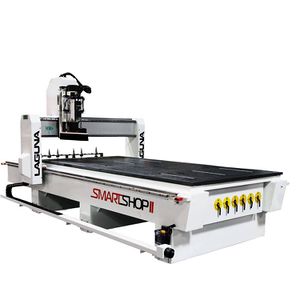Difference between revisions of "CNC Router"
| Line 79: | Line 79: | ||
Foxtale Quiz | Foxtale Quiz | ||
| + | https://foxtale.georgefox.edu/moodle/course/view.php?id=30809 | ||
==Troubleshooting== | ==Troubleshooting== | ||
Revision as of 16:23, 4 June 2020
Make: Laguna
Model: SmartShop II
Ace: Needed (Makerhub@georgefox.edu).
Location: Wood Shop
Description
The Laguna SmartShop II is a CNC wood router capable of cutting out complex shapes that would otherwise be difficult to create by hand. Like all CNC machines, the SmartShop II is most useful when a design calls for a high level of precision, or is being mass produced.
Here is an example of this piece of equipment being used.
Documentation
Terminology
Insert terminology here
Training
Operation
To get started you will need to get a .DXF file from Solidworks or another program. The .DXF file will need to be imported into VCarve Pro software. VCarve is used to create the G-code used by the router. You will select the type of cuts and tooling inside the software. Most cutting jobs can be done using a 1/4" cutter. A good rule of thumb is to not exceed the diameter of the tool in depth per pass. In foam or soft materials you can cut deeper per pass. The large switch near the middle of cabinet is the main power. There is a key located on the control panel that also needs to be turned to the on position for the PC inside the machine to boot. After power up, make sure the table is clear before pressing the home button. The machine will move to the corner closest the control panel after moving the Z, X, and y axis to home position. Always keep your body outside the safety line while the machine is moving.
Demonstration
For the demonstration you will need to import a DXF file into VCarve Pro and convert it to G-code. You will also need to demonstrate safe startup and use of the router using the G-code file you produced.
General Procedure
- To start a new project, you must first select “Create a new file.”
- Next, you will be prompted to input the width, height, and thickness of the material. Click Ok to move on to the next step.
- Now select "import vector".
- Make sure all the pieces are close together, but make sure they don't overlap.
- Starting with the inside features, you will hold the shift key and select all of the holes. Once they are all selected, go to Tool Path and select the Profile Tool Path. Choose your cut depth, tool, parameters, and then select OK. Double-check that Inside Cut is also selected, and check the box for Ramp.
- To save the inside cutout tool path, select Calculate and OK.
- You can now preview this first tool path to ensure that it is running exactly how you want it.
- Switch back to the 2D view and begin the process for cutting out your logo or design. This starts by holding down the shift key and selecting the logo.
- Select VCarve, and make sure the settings are correct. If you are satisfied, select Calculate and OK again. You can preview this part of the process as well.
- Go back to the 2D view to begin the outside cutout process.
- Holding the shift key down, you can now select the outer pieces that need to be cut out. Then select Close on the right side of the screen.
- Next, choose Tool Path, select Outside Cut, and change your tool and parameters as needed. Check the box for adding a Ramp, and hit Calculate.
- Now you can preview the entire process before giving it the green light.
- Once you are happy with the design, you can transport the files onto a flash drive to import onto the machine.
Safety
There are multiple hazards you need to be aware of when using the CNC router.
- The tooling is very sharp and spins at over 18,000 RPM. Keep your body parts away from the cutter and spindle.
- Stay behind the safety line when operating the router. The router is very large and will not stop if you get in its way.
- Materials need to be securely fastened to the table by vacuum or mechanical means.
- Never attempt to cut a hole the same diameter as the cuter with a down cut force cutter. This will compress the chips and can create a fire due to the air draw of the vacuum table.
Certification
Foxtale Quiz https://foxtale.georgefox.edu/moodle/course/view.php?id=30809
Troubleshooting
- If none of the control functions on the control panel appear to work, make sure the machine has been homed and the E-stop is released.
- If the cutting tool height appears to be incorrect make sure the tool touch off has been performed for the tool in use.
Maintenance
General maintenance
- The spoil board needs to be resurfaced as grooves are cut into the surface. Grooves will release a percentage of the table vacuum and increase the risk of the material moving during cutting.
- There are many bearing surfaces located on the router that need to be lubricated. The router is equipped with a central lubrication system the technician will operate on a regular basis.
Specific Maintenance Tasks
| Maintenance Procedure | Frequency | Done By |
|---|---|---|
| Sample | Sample | Sample |
